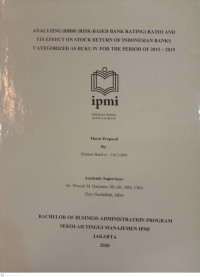
Analyzing RBBR (Risk-Based BANK Rating) Ratio and Its Effect on Stock Return of Indonnesian Banks Categorizes As Buku IV for The Period of 2015 – 2019
| Gmd : Text
| Availability :
| 2020CS186 | CS/186 | IPMI Kalibata (THESIS S1) | Available |
This research aims to determine the health level based on Risk-Based Bank Rating (RBBR) and understand the effect of bank’s health rate on the stock return which are listed in Indonesia Stock Exchange and categorized as BUKU IV in 2015 - 2019. Bank’s health rate is assessed through Risk-Based Bank Rating method which includes three factors. The first is risk profile factor which is proxied by Non-Performing Loan (NPL) and Loan to Deposit Ratio (LDR), the second earning factor proxied by Return on Assets (ROA) and Net Interest Margin (NIM), and the last factor is capital factor which is proxied by Capital Adequacy Ratio (CAR). The population of this study are banking companies which already go public and is categorized under BUKU IV. This study used purposive sampling technique using 7 banks or 100% of total sampling. RBBR analysis is used to determine health level of each RBBR ratio of the banks and Multiple regression analysis is used to test the hypotheses. The result of this research showed that majority of banks under BUKU IV are in sound health based on RBBR method, and also the research indicated that NPL, LDR, ROA, NIM, and CAR are not proven to have effect on the stock return.
Keywords: BUKU IV, bank’s health, Risk-Based Bank Rating, stock return, risk profile, earning, capital
| Series Title |
-
|
|---|---|
| Call Number |
CS/186
|
| Publisher Place | Jakarta |
| Collation |
ii, 61p; 30cm
|
| Language |
English
|
| ISBN/ISSN |
-
|
| Classification |
CS/186
|
| Media Type |
-
|
|---|---|
| Carrier Type |
-
|
| Edition |
-
|
| Subject(s) | |
| Specific Info |
-
|
| Statement |
-
|
| Content Type |
-
|
No other version available







